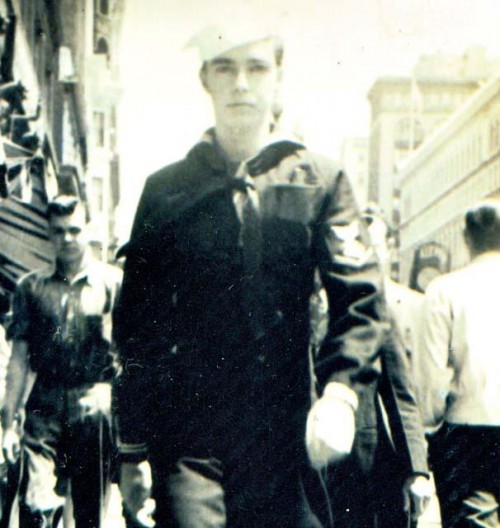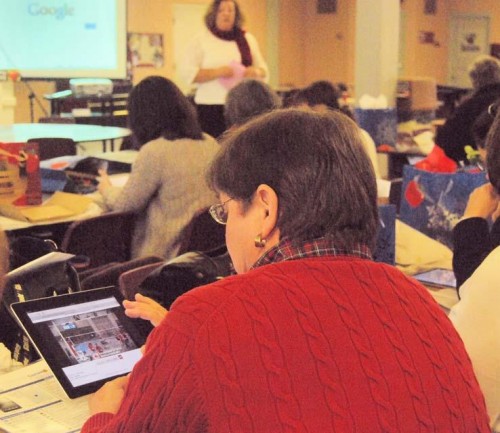GCCF doubles seafood payment formula
December 7, 2011
WWII radioman tours the Pacific
December 9, 2011By issuing each member of its faculty an early Christmas gift, E.D. White cemented its intent to dive headlong into the education-technology movement.
Faculty members received giftbags containing Apple iPad 2.0s, the latest indicator of the school’s pursuit of its almost-satisfied, $300,000 quest to equip the infrastructure needed to sync with the techno-savy youth.
“Once we pass these out, it’s the beginning of what could be a new way to meet the ever-changing needs of the kids at E.D. White,” President David Boudreaux said.
The entire student body is scheduled to receive iPads in time for the start of 2012-13 school year, Boudreaux said. It will be the first school in the Tri-parish region to issue the technology to all of its students and faculty.
Principal Michelle Chiasson said the transition will foster an atmosphere that appeals to the students’ strengths and allows the eighth- through 12th-graders to be themselves inside the school’s classrooms.
“The days of a teacher lecturing are just gone, especially with young people being raised in a wired environment,” Chiasson said. “We’re telling them to turn off the way you live outside of school, and take out your notebook and a pen and start writing. We’re just not connecting with them, so instead of fighting their world, we’re tapping into that now.”
E.D. White has already installed a fiber optic Internet line to support a high-speed broadband connection. The school, with emitters in every building, will be able to handle 800 to 900 tablets, Boudreaux said.
The iPads cannot reach the 3G network, which essentially allows Internet access anywhere. Instead, students and teachers will be required to log-on through the school’s Wifi connection through its firewall, which prevents browsing unsanctioned websites.
In January, Chiasson present iPads to two classrooms. The students will be permitted to experiment with the tablets so that the “we can work the bugs out,” Boudreaux said.
In Houma, five teachers are piloting an iPad program at Vandebilt Catholic and five more are slated to be issued the devices after Christmas, said Lisa Vegas, director of advancement and public relations at the school.
The school plans to issue iPads to its 10th-, 11th- and 12th-grade students at the start of next year and is in the process of finalizing a plan for eighth- and ninth-grade adoption down the road.
Vegas said that about 100 students have entered into an agreement with the administration that allows them to use personal laptops, tablets and e-readers in the classroom.
Maria Cruse, a Thibodaux psychiatrist and member of the E.D. White advisory council, helped lead a fundraising effort that brought in $300,000. She said the community quickly embraced the idea.
“In all the different things I’ve been involved with Thibodaux the last 15 years of fundraisers, this was the easiest money to raise,” Cruse said. “Everybody got it.”
Justin Gibson, director of information technology with the Archdiocese of New Orleans, has helped nine schools implement iPads. He said the Apple product is a better tablet than similar productions by Amazon and Verizon because of its operational consistency across multiple platforms and expansive library of applications, or apps.
“The amount and variety of the apps already created for it number in the hundreds of thousands,” he said. “Apple, they’re very domineering and controlling in there, but at least what it does, everything works because they make sure it works before it gets on their device.”
E.D. White will own the iPads, but the teachers were encouraged to take them home, download mp3s and video and customize the machines to their liking.
The teachers were also given a $20 iTunes gift card to purchase applications, or apps, they find beneficial to education.The school will purchase in bulk a spreadsheet, video and note-taking app, but the teachers are free to choose the appropriate apps according to their subject matter.
Chiasson was paticularly excited when she talked about an app that transforms the periodic table from an antiquated chart with abbreviations and numbers to a vibrant and interactive outline that allows students to peruse an element’s uses and pictures from the tablet.
The future of textbooks is also appealing to administrators. The burden on a student’s back will be replaced by a 7.3- by 9.5-inch, 1.3-pound tablet. Digital textbooks, in some cases, could be purchased by chapter n which would allow teachers to tailor their syllubi to the books’ strengths n and could be updated annually, instead of five years at a time, Chiasson said.
Replacing the necessity to lug books back and forth to school with digital versions loaded onto the e-readers is an idea with which everyone, regardless of age, can empathize.
But the transition hasn’t been easy. Some textbook publishers have been reluctant to the change, as a new publishing revenue model is still being hammered out in boardrooms across the globe. Gibson said that as of now, textbook capability is the “weakest area” of tablets’ educational benefits.
It is, however, evolving. The Florida Legislature passed a bill earlier this year mandating public schools to adopt a digital-only textbook system by the 2015-16 school year. School districts must spend at least half of their textbook budget on digital materials until then.
In addition to the techno-advancement spurned within state lines, the move puts pressure on the textbook companies who have resisted a move to the digital medium. Coupled with the announcement that Adobe has discontinued its development of Flash, which supported textbooks, Gibson said he expects all textbook publishers will develop for e-readers by 2015. “The whole textbook industry is going to need to change,” he said.
In the meantime, students and faculty will enjoy the many perks afforded by the tablet and its technology.
Anyone can create an app, and Chiasson said she believes E.D. White students may be willing and able to create apps that benefit the school. A lunch-line directive app, for example, would benefit everyone, she said.
“I saw a link somebody sent me last week, a sixth-grader who is designing his own apps,” Chiasson said. “Our students will be able to do that. They may be doing that right now.”
Teachers at E.D. White High School received iPads last week, the school’s next step in handing out the tablets to all of its students by August 2012. The school is undertaking the initiative to better connect with the techno-savvy youth, according to administrators. ERIC BESSON










